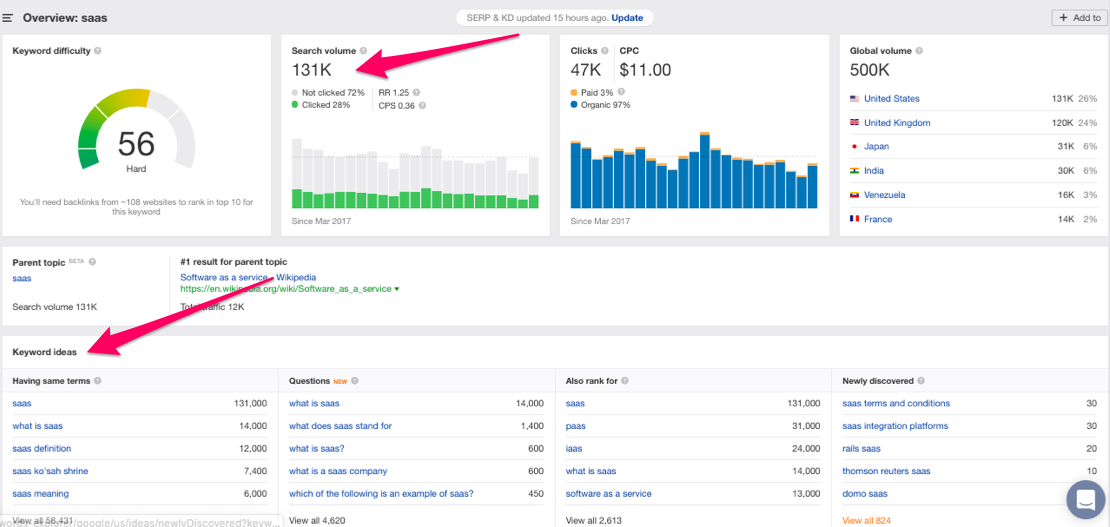Article's Content
What exactly is the key to a strong content marketing strategy for B2B companies?
Most content marketers respond in two ways:
- It’s important to create quality content
- It’s important to create lots of content
That’s great but this ideology that you have to choose between quality and quantity is misplaced. Some of the most popular blogs and brands have grown their traffic to reach millions by doubling down their effort on both of these ideas. Brands like Vice publish TONS of high-quality content every single week and brands like BuzzFeed are the definition of a blend between high-quality content and high quantity.
What if I told you that you too could have both?
That you could overcome the struggle of coming up with new blog ideas and overcome the challenge of writing more blog posts. Would you be interested?
Well, it’s your lucky day.
In this blog post, we’re going to share with you 4 easy steps on how to keep your content fresh and plentiful. In addition, I’m going to share with you a simple process that we’ve taken at Foundation to help create content that ranks and gets shared by thousands.
Let’s get to it…
Start By Writing Down Your Content Headline Ideas In One Place
First things first. All those ideas floating in your head?
Write them down.
You may think that you can remember all of these super creative and usable ideas, you won’t. So take a couple hours and write down any of your ideas no matter how good or bad they might be. The intent of this list of headline ideas is a bank of content topics that you can come back to time and time again in the future.
Don’t limit yourself to a day though.
Keep an online notepad, Google doc, spreadsheet or, as silly as it sounds, a thought diary, and write down the ideas that strike you at random. Everyone has a different approach for this but it’s an important practice that can help you come back to quality ideas months after they first hit you.
Here’s a thought diary that one of our team members uses on a regular basis:


Now you might be thinking:
That sounds great but…. Where do I get content ideas?
Here are a couple of go-to strategies that we use for coming up with content ideas:
Use Keyword Research To Find Content Ideas
Tools like Moz and Ahrefs can be great resources for getting a better understanding of what keywords people are looking for as it relates to your content.
Here’s a quick snapshot for ideas that popped up when researching the keyword ‘SaaS’.


Doing keyword research isn’t rocket science—Here’s a 30-minute guide to conducting keyword research from Brittney Muller that is filled with great ideas.
Use Content Apps To Find Content Inspiration
You can also leverage tools like Zest.is and BuzzSumo to come up with great content ideas. On both of these tools, you can type in a few keywords that are relevant to your industry and be met with content inspiration from around the web.
Use Crowdsourcing To Find Content Ideas
Don’t forget to leverage your community and customers. Ask the people who you serve on a daily basis what it is that they’d like to learn more about and deliver that content to them. Create content that answers their most frequently asked questions and send out messages on social media asking for topics that they’d like you to cover in the future. It’s an idea that works wonderfully well for both solopreneurs and companies.
I’m going to be creating some educational content this year. 📚🤓 Which topic do you want me to cover first?
— Shanelle Mullin (@shanelle_mullin) February 19, 2019
Use Past Experiences To Find Content Ideas
One of the best places to find content ideas is in the past. Think about some of the things that your organization has done and write about them as parts of your content plan. What events have you recently attended that could offer quality insight to your customers or target audience? Create a roundup of quotes from attendees or a recap of the most popular talks.
Use Communities To Find Content Ideas
I’ve yet to find an industry, service or product that doesn’t have a passionate group of people online talking about it in some form. Find these communities and get inspiration from some of the most passionate people in your space. Sort forums by most popular discussions and put up posts asking what they wish they knew 5 years ago. Online communities are a great place for finding content inspiration. So whether you are a part of Facebook groups or a Slack community, reach out to people and you’d be surprised by the number of content ideas!
Now you have this document filled with random ideas.
What to do with them?
How To Pick The Content Ideas That Are Going To Drive Results
Always pick the content ideas that you have the most to say about. That is:
Pick content ideas where you know that you’ll be able to go above and beyond the status quo and deliver value that surpasses the competition.
This doesn’t mean that the content has to be 40,000 words but longer content is preferred by search engines. Here’s a study conducted by Moz that supports this idea that the longer the post, the better the chances of showing up in Google or Bing for specific keywords:


In the study, Moz writes: “Long-form content consistently gets higher average shares and significantly higher average links.” Thus, it’s important that you invest the time and energy into creating content that is jam-packed with quality insights and choose the topics that you know for certain you can provide that level of great information.
As you keep your list of content ideas, keep track of similar ideas, as they can be used as points in your article and linked back to in the future. If you get on a roll in the content inspiration phase, it’s very possible that you could create an entire batch of content surrounding one topic.
That’s great.
For the quantitative aspect, similar blog ideas can be separated and spread out. For example, a broader topic like productivity can be tackled from multiple angles while keeping each post unique and fresh. In doing so, there is also an SEO benefit as you can create a keyword bubble surrounding a specific topic. Hubspot calls this topic clusters.
Here’s a video that explains what this is why’s it’s relevant with the changing content marketing landscape:
This strategy is a great way to grow traffic for a keyword that is important to your brand’s growth strategy.
How To Craft The Content To Be Search Friendly & Share Worthy
You’ve narrowed down to an idea now, so let’s get to writing.
Similar to the first thought on content creation, it’s important that you go above and beyond on your given topic. For example, if your topic is on How B2B Brands Can Leverage eCommerce to Drive Results, include research or case studies on why eCommerce matters, personal experiences, and maybe an overview on the role that eCommerce has played in changing the landscape for B2B as a whole.
It may sound like overkill at first glance, but delivering this type of value for your readers can be extremely beneficial for showcasing the expertise of your team. You’ll also notice when you start writing that your ideas and thinking will branch off into new concepts, new research, new insights, and new directions.
Let that happen!
When you’re writing the blog post, a few insights from Brian Dean of Backlinko that every marketer should keep in mind when crafting their message include:
- Include Your Target Keyword In Your First 100 Words
- Use Outbound Links To Related Pages For Relevancy Signals
- Add 2-3 Internal Links For Every Post On Your Blog
- Use LSI Keywords To Help With Content Relevancy
Here’s the infographic he put together about on-site content optimization for marketers. It’s a straightforward resource that is so jam packed with insight that we share it with every marketer who joins the Foundation team on day one.
Once you’ve ensured that your content is optimized for search, it’s time to optimize your content for social sharing. Similar to the way that you can increase the chances that your content get found on Google, you can increase the chances that your content is shared on Facebook.
Here are a few tips on creating share worthy content:
- Include Call To Actions To Share Throughout Your Content
- Include Images That Can Be Shared On Social Media
- Debug Your Content On Twitter & Facebook For Social Sharing
- Send An Email To Your Newsletter Asking To Share
- Include Social Sharing Buttons On Your Website
- Leverage Tools Like Sumo For On-Site Sharing
- Conduct Outreach After Going Live Asking For Shares
- Distribute Your Content Into Communities Of Relevance
- Share The Content On Your Own Social Media Channels
Now, you might be thinking….
Whoa!
This sounds like a lot of work just to make a piece of content shareworthy… You’re right. It is.
But it’s this extra bit of work that most marketers aren’t willing to do that separate the best marketers from the rest. Ross has talked about this idea plenty of times in his content:
The Final Step In Content Creation Is Proofing & Publishing
Before you get to publishing you have one last step… The edit!
It’s super awkward to have it published only to find a very noticeable mistake hidden among your work. Stop this before this becomes a problem. Check your grammar to make sure the message flows and check your spelling to avoid any awkward typos.
Another thing to check is whether you keep your article on track. If you go slightly off course, are you bringing it back to your main point? And are you making your point easily discernible? An easy way to see whether or not is asking yourself whether or not someone not in the field would understand. Basic jargon and clear concise points are a content marketer’s best friend.
Timing is key!
Yes, it’s a cliche, but that doesn’t mean it isn’t true.
Check your analytics for the times in which your website is the most popular, when your newsletter generates the most clicks and when you see the most impressions on social. Use these insights to ensure that you’re publishing your content at the right time and on the right channels. It’s important that you maximize the reach for your content and by lining up your distribution and publishing efforts with ideal times – you increase the chances of creating content that will be shared and seen.
Wrapping Things Up
At the end of the day, creating a high volume of content and high quality of content is one of the biggest challenges a brand can face. If you’re up for the challenge, it’s our hope that these different strategies and tactics can become a part of your process and you can use them to become a lean, mean content creating machine.
But we recognize that not everyone is going to have that in them… That’s why we exist. We help brands create content worth sharing and assist in ensuring that the content is distributed to the right audiences in the right ways. If you’re interested in learning more about how our content marketing services could help you grow – Get in touch. We’d love to chat.








